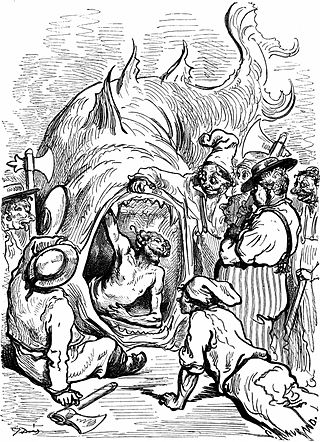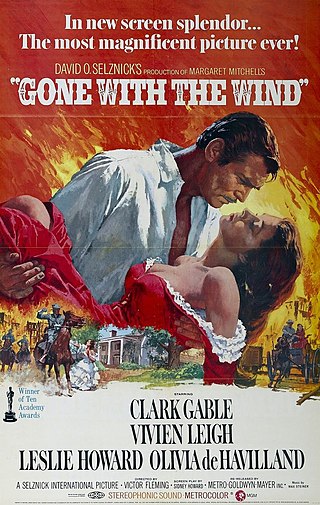This article needs additional citations for verification .(December 2009) |
"Man vs technology" is a type of conflict in fiction, [1] of which The Terminator and The Matrix are popular examples.
This article needs additional citations for verification .(December 2009) |
"Man vs technology" is a type of conflict in fiction, [1] of which The Terminator and The Matrix are popular examples.
Conflict (narrative) for a list of narrative conflicts.

A role-playing game is a game in which players assume the roles of characters in a fictional setting. Players take responsibility for acting out these roles within a narrative, either through literal acting or through a process of structured decision-making regarding character development. Actions taken within many games succeed or fail according to a formal system of rules and guidelines.

In a literary work, film, or other narrative, the plot is the sequence of events in which each event affects the next one through the principle of cause-and-effect. The causal events of a plot can be thought of as a series of events linked by the connector "and so". Plots can vary from the simple—such as in a traditional ballad—to forming complex interwoven structures, with each part sometimes referred to as a subplot or imbroglio.

In fiction, a character is a person or other being in a narrative. The character may be entirely fictional or based on a real-life person, in which case the distinction of a "fictional" versus "real" character may be made. Derived from the Ancient Greek word χαρακτήρ, the English word dates from the Restoration, although it became widely used after its appearance in Tom Jones by Henry Fielding in 1749. From this, the sense of "a part played by an actor" developed. Character, particularly when enacted by an actor in the theatre or cinema, involves "the illusion of being a human person". In literature, characters guide readers through their stories, helping them to understand plots and ponder themes. Since the end of the 18th century, the phrase "in character" has been used to describe an effective impersonation by an actor. Since the 19th century, the art of creating characters, as practiced by actors or writers, has been called characterisation.
A prequel is a literary, dramatic or cinematic work whose story precedes that of a previous work, by focusing on events that occur before the original narrative. A prequel is a work that forms part of a backstory to the preceding work.
A backstory, background story, back-story, or background is a set of events invented for a plot, presented as preceding and leading up to that plot. It is a literary device of a narrative history all chronologically earlier than the narrative of primary interest.
Action fiction is a literary genre that focuses on stories that involve high-stakes, high-energy, and fast-paced events. This genre includes a wide range of subgenres, such as spy novels, adventure stories, tales of terror and intrigue and mysteries. This kind of story utilizes suspense, the tension that is built up when the reader wishes to know how the conflict between the protagonist and antagonist is going to be resolved or what the solution to the puzzle of a thriller is.

A narrative, story, or tale is any account of a series of related events or experiences, whether nonfictional or fictional. Narratives can be presented through a sequence of written or spoken words, through still or moving images, or through any combination of these. The word derives from the Latin verb narrare, which is derived from the adjective gnarus. The formal and literary process of constructing a narrative—narration—is one of the four traditional rhetorical modes of discourse, along with argumentation, description, and exposition. This is a somewhat distinct usage from narration in the narrower sense of a commentary used to convey any written narrative. Many additional narrative techniques, particularly literary ones, are used to build and enhance any given story.

An unreliable narrator is a narrator whose credibility is compromised. They can be found in fiction and film, and range from children to mature characters. The term was coined in 1961 by Wayne C. Booth in The Rhetoric of Fiction. While unreliable narrators are almost by definition first-person narrators, arguments have been made for the existence of unreliable second- and third-person narrators, especially within the context of film and television, and sometimes also in literature.
Narrative poetry is a form of poetry that tells a story, often using the voices of both a narrator and characters; the entire story is usually written in metered verse. Narrative poems do not need to rhyme. The poems that make up this genre may be short or long, and the story it relates to may be complex. It is normally dramatic, with various characters. Narrative poems include all epic poetry, and the various types of "lay", most ballads, and some idylls, as well as many poems not falling into a distinct type.
A single-player video game is a video game where input from only one player is expected throughout the course of the gaming session. A single-player game is usually a game that can only be played by one person, while "single-player mode" is usually a game mode designed to be played by a single player, though the game also contains multi-player modes.
Ruritania is a fictional country, originally located in central Europe as a setting for novels by Anthony Hope, such as The Prisoner of Zenda (1894). Nowadays the term connotes a quaint minor European country, or is used as a placeholder name for an unspecified country in academic discussions. The first known use of the demonym Ruritanian was in 1896.
In philosophy, ethical dilemmas, also called ethical paradoxes or moral dilemmas, are situations in which an agent stands under two conflicting moral requirements, none of which overrides the other. A closely related definition characterizes ethical dilemmas as situations in which every available choice is wrong. The term is also used in a wider sense in everyday language to refer to ethical conflicts that may be resolvable, to psychologically difficult choices or to other types of difficult ethical problems. This article is about ethical dilemmas in the strict philosophical sense, often referred to as genuine ethical dilemmas. Various examples have been proposed but there is disagreement as to whether these constitute genuine or merely apparent ethical dilemmas. The central debate around ethical dilemmas concerns the question of whether there are any. Defenders often point to apparent examples while their opponents usually aim to show their existence contradicts very fundamental ethical principles. Ethical dilemmas come in various types. An important distinction concerns the difference between epistemic dilemmas, which give a possibly false impression to the agent of an unresolvable conflict, and actual or ontological dilemmas. There is broad agreement that there are epistemic dilemmas but the main interest in ethical dilemmas takes place on the ontological level. Traditionally, philosophers held that it is a requirement for good moral theories to be free from ethical dilemmas. But this assumption has been questioned in contemporary philosophy.
Story structure or narrative structure is the recognizable or comprehensible way in which a narrative's different elements are unified, including in a particularly chosen order and often specifically referring to the ordering of the plot: the narrative series of events. In a play or work of theatre especially, this can be called dramatic structure, which is presented in audiovisual from. The following overviews how story structure works in a cross-cultural and general sense.

An antagonist is a character in a story who is presented as the main enemy and rival of the protagonist.

Traditionally, conflict is a major element of narrative or dramatic structure that creates challenges in a story by adding uncertainty as to whether the goal will be achieved. In works of narrative, conflict is the challenge main characters need to solve to achieve their goals. However, narrative is not limited to a single conflict. In narrative, the term resolution refers to the closure or conclusion of the conflict, which may or may not occur by the story's end.
In contemporary literary studies, a theme is a central topic, subject, or message within a narrative. Themes can be divided into two categories: a work's thematic concept is what readers "think the work is about" and its thematic statement being "what the work says about the subject". Themes are often distinguished from premises.
Text types in literature form the basic styles of writing. Factual texts merely seek to inform, whereas literary texts seek to entertain or otherwise engage the reader by using creative language and imagery. There are many aspects to literary writing, and many ways to analyse it, but four basic categories are descriptive, narrative, expository, and argumentative.
Postmodernism in political science refers to the use of postmodern ideas in political science. Postmodernists believe that many situations which are considered political in nature can not be adequately discussed in traditional realist and liberal approaches to political science. Postmodernists cite examples such as the situation of a Benedictine University “draft-age youth whose identity is claimed in national narratives of ‘national security’ and the universalizing narratives of the ‘rights of man,’” of “the woman whose very womb is claimed by the irresolvable contesting narratives of ‘church,’ ‘paternity,’ ‘economy,’ and ‘liberal polity.’ In these cases, postmodernists argue that there are no fixed categories, stable sets of values, or common sense meanings to be understood in their scholarly exploration.
Slice of life is a depiction of mundane experiences in art and entertainment. In theater, slice of life refers to naturalism, while in literary parlance it is a narrative technique in which a seemingly arbitrary sequence of events in a character's life is presented, often lacking plot development, conflict and exposition, as well as often having an open ending.

In film and television, drama is a category or genre of narrative fiction intended to be more serious than humorous in tone. Drama of this kind is usually qualified with additional terms that specify its particular super-genre, macro-genre, or micro-genre, such as soap opera, police crime drama, political drama, legal drama, historical drama, domestic drama, teen drama, and comedy-drama (dramedy). These terms tend to indicate a particular setting or subject-matter, or else they qualify the otherwise serious tone of a drama with elements that encourage a broader range of moods. To these ends, a primary element in a drama is the occurrence of conflict—emotional, social, or otherwise—and its resolution in the course of the storyline.